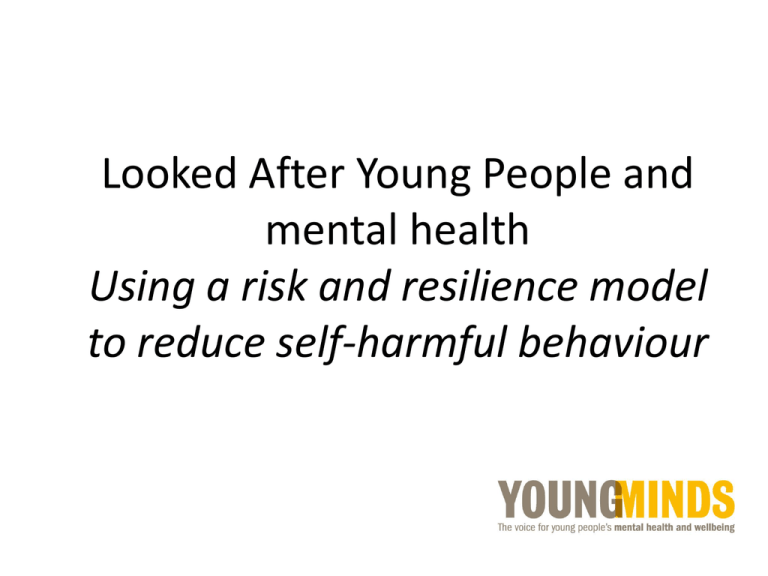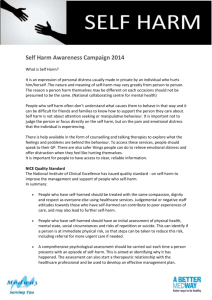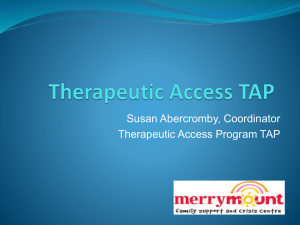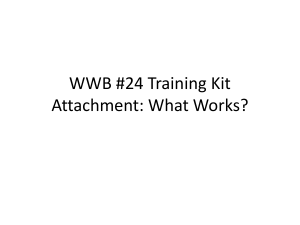
Looked After Young People and
mental health
Using a risk and resilience model
to reduce self-harmful behaviour
Today’s programme
• Mental health: Definitions and context
• Mental Health risk factors and Looked
After Children
• Self-harming behaviour
• Resilience Framework and Looked After
Children
Mental health: A definition
‘the strength and capacity of our minds to
grow and develop, to be able to overcome
difficulties and challenges and to make the
most of our abilities and opportunities’
YoungMinds 2006
Think about the young people who you work
with. Consider the following:
How would you know if a young person’s mental health
was good?
How would they behave?
Describe behaviour that would make you concerned.
Child Mental Health
• A capacity to enter into, and sustain, mutually satisfying
and sustaining personal relationships
• Continuing progression of psychological development
• An ability to play and to learn so that attainments are
appropriate for age and intellectual level
• A developing moral sense of right and wrong
• A degree of psychological distress and maladaptive
behaviour within normal limits for the child’s age and
context
Problems & Disorders
Mental health problem
A disturbance of function in one area of; relationships,
mood, behaviour or development, of sufficient
severity to require professional intervention.
Mental disorder
A severe problem (commonly persistent) or the cooccurrence of a number of problems, usually in the
presence of several risk factors
A bio-psycho-social model
NATURE (what we are born with)
EVENTS
(what happens to us)
NURTURE (what we
grow up with)
Prevalence among children
aged 5 – 15 in the UK
Risk factors
but no obvious
problems now
Mental health
problems
3 million or
20%
1.5
million
or 10%
Mental or
psychiatric
disorder
30,000 or
0.2%
Severe disorder or
mental illness
What are risk factors?
Conditions, events or circumstances that are
known to be associated with emotional or
behavioural disorders and may increase the
likelihood of such difficulties
• Risk is cumulative
• Risk is not causal but can predispose children to
mental health problems
Risk and protective factors
Risk Factors
Protective
Factors
Task
• Consider the following:
What experiences may a child have prior to
coming into care, that may effect their mental
health?
Predisposing factors - child
•
•
•
•
•
•
Genetic influences
Low IQ and learning disability
Specific developmental delay
Communication difficulty
Difficult temperament
Physical illness, especially if chronic and/or
neurological
• Academic failure
• Low self-esteem
Predisposing factors - family
•
•
•
•
•
•
•
•
•
Overt parental conflict
Family breakdown
Inconsistent or unclear discipline
Hostile and rejecting relationships
Failure to adapt to child's changing developmental needs
Abuse - physical, sexual and/or emotional
Parental criminality, alcoholism & personality disorder
Parental psychiatric illness
Death & loss - including loss of friendships
Predisposing factors - environment
•
•
•
•
•
Socio-economic disadvantage
Homelessness
Disaster
Discrimination
Other significant life events
Attachment Theory
Attachment behaviour is defined as:
The seeking of protection when anxious
which is triggered by external threats or
behaviours
The person to whom a child is attached
provides a secure base, a place of safety,
warmth and comfort
Attachment Theory
A securely attached child feels confident that should
they feel anxious, their parents will respond. Such
security is brought on by interactions which are:
• Sensitive
• Regularly available and reliable
• Warm
• Responsive
• Consistent
Way attachment develops
need
relaxation
trust
security
attachment
satisfy
need
arousal - relaxation cycle
high
arousal
Secure and insecure attachment
“A securely attached child is likely when faced with potentially
alarming situations .... to tackle them effectively or seek help
in doing so”
Children whose needs have not been adequately met see the
world as;
‘comfortless and unpredictable and they respond by either
shrinking from it or doing battle with it.’
Bowlby (1980) Attachment and loss Vol. 3 and Bowlby (1973) Attachment and loss Vol. 2
Insecure Avoidant
• Caregiver subtly or overtly reject child’s attachment
needs at time of stress
• Bids for comfort will be rebuffed
• Child keeps his/her attention directed away from their
caregivers in an effort not to arouse anxiety and
frustration
• In control because of the need for self reliance
• Comfort self rather than accept it from others
Insecure Ambivalent/Anxious
Caregiver will be inadequate at meeting child
attachment needs (caregiver is passive, unresponsive
and ineffective)
Child’s strategy is to amplify attachment needs and
signals in an effort to arouse a response (verbal and
behavioural: bubbly affection to rage, anger, panic and
despair. All experienced as controlling)
Child may constantly feel that needs are unmet
Insecure Disorganised
Child experiences the carer giver as ‘the source of alarm
and its only solution’. (Children from abusive families)
Child in these circumstances is unable to be guided by
their mental model of the world because it offers few
directions.
Frightened, helpless, fragile and sad
At risk of mental health problems or anti-social behaviour
In Essence…
Attachment needs are activated during times
of perceived stress (discomfort,
environmental, danger, fatigue, illness)
The child must either have these attachment
needs met or find other ways to cope.
Adolescent attachment styles
Compulsive self-reliance
Distrusts relationships, avoids being rejected or relied upon. Prone
to depression or psychosomatic symptoms.
Compulsive care giving
Actively involved in relationships but always as a care giver. Own
parents unable to provide care but might have demanded it from
child.
Care-seeking
Vigilant to signs of loss or abandonment. Constantly anxious.
Parents probably unresponsive or threatened to leave family.
Angry withdrawal
Generalised anger towards attachment figure who is seen as
unavailable.
Positive brain development
The way a child is stimulated shapes the brain’s
neurobiological structure. Experience has a direct
impact on a child’s capacity for living, learning and
relating as a social being.
Early Brain Development
We are born with most of the neurons (brain cells) we will ever own but;
At
birth the brain is 25% of its adult weight - by the age of 2
this has increased to 75% and by age 3 it is 90% of adult
weight.
This growth is largely the result of the formation and ‘hard
wiring’ of synaptic connections
Babies brains are both ‘experience expectant’ and
‘experience dependent’
Proliferation of synapses
The Learning Years: 5-10
• Synaptic pathways that are regularly used are reinforced.
This is the basis of learning. Reinforcement leads to
permanent neurological pathways.
• Neural connections needed for abstract reasoning are
developed
• Motor skills are refined
Adolescent Brain Development
• Brain development continues up to at least the age of 20
• There is a significant remodelling of the brain in
adolescence, particularly the frontal lobes and
connections between these and the limbic system
• The frequency and intensity of experiences shapes this
remodelling as the brain adapts to the environment in
which it is functioning and becomes more efficient
Emotional Functioning
• There is a mismatch between emotional and cognitive
regulatory modes in adolescence
• Brain structures mediating emotional experiences
change rapidly at the onset of puberty
• Maturation of the frontal brain structures underpinning
cognitive control lag behind by several years
• Adolescents are left with powerful emotional responses
to social stimuli that they cannot easily regulate,
contextualise, create plans about or inhibit
Impact of trauma
In the face of interpersonal trauma, all the systems of
the social brain become shaped for offensive and
defensive purposes. A child growing up surrounded
by trauma and unpredictability will only be able to
develop neural systems and functional capabilities
that reflect this disorganisation.
Source: National CAMHS Support Service, Everybody’s Business
Traumatic stress
When children and young people experience persistent stress
they are likely to produce toxic amounts of cortisol which can
have a detrimental effect on
Brain function
All major body systems
Social functioning
Over production of stress hormones
These functions may be diminished or lost:
Ability to learn language and to speak
Understanding feelings or having words to describe them
Connection between how we feel and our sensory
experience
Empathy
Control of impulse
Regulation of mood
Short term memory
Enjoyment
Reducing Risk
Consider the different risk factors we talked
about earlier and the effects of early years
experiences
What can you do to ensure that these risk
factors are not increased once a young person is
in care?
What worries us?
Teachers, GPs, parents and young people were asked to
rate the following concerns in order of how worried
they would be if a young person they knew were
affected by the following issues:
HAVING RISKY SEX
HAD AN EATING DISORDER
BINGE DRINKING
BEING BULLIED
SELF HARM
SMOKING
USING DRUGS
WAS A GANG MEMBER
Self-Harm
How would you define self-harm?
What feelings arise when you think about selfharm?
Defining Self harm
• When some people feel sad, desperate, angry or
confused, they can hurt themselves. This is called
‘self-harm’.
• People can do this in a number of ways and for
different reasons.
• People who harm themselves on more than one
occasion may do so for a different reason each time.
They may also harm themselves and not tell anyone
about it
NICE Guidance on Self Harm (2004)
truth hurts
Young people who self-harm do so because they have no other
way of coping with problems and emotional distress in their
lives…. It provides only temporary relief and does not deal with
the underlying issues.’
Truth Hurts, Mental Health Foundation (2006)
http://www.mentalhealth.org.uk/publications/truth-hurts-report1/
How Common is it?
In every secondary
school classroom
there will be two
young people who
have self-harmed
How common is it?
• Between 1 in 12 and 1 in 15 young people self-harm
(truth hurts 2008)
• 7% of young people aged 15-16 in England self-harm
(Hawton, et al., 2002)
• 37,000 young people presented to hospital in 2010/11
and many report previous episodes when they did not go
to hospital (hospitals admissions statistics 2010)
• Inpatient admissions of young people under 25 for self
harm have increased by 68% in the last 10 years
(hospitals admissions statistics 2010)
The ONS report ‘Mental Health of Children and Young People in Great Britain,
2004’ found that:
• 28% of children aged 11-16, with an emotional disorder
reported that they have self-harmed. This compares to 6%
without an emotional disorder.
• 21% of children aged 11-16, with a conduct disorder reported
that they have self-harmed. This compares to 6% without a
conduct disorder.
• 18% of children aged 11-16, with a hyperkinetic disorder
reported that they have self-harmed. This compares to 7%
without this disorder.
• 25% of parents, who had a child with an autistic spectrum
disorder, reported that their child had self-harmed, compared
to on 2% whose children did not have the disorder.
Is there a link between self harm and suicide?
• While studies have shown that young people
who self-harm are more at risk of suicide,
people don’t necessarily self-harm because
they want to take their own lives.
• The young people we work with describe self
harm as a coping mechanism to manage
overwhelming feelings; and young people who
took part in this survey (TASH) describe it as a
diversion of painful feelings.
Why do young people self harm?
“The thoughts are in my
head every day, I can’t
take it. Cutting myself is
“the only way I can deal
with him being around.”
Cutting takes my
mind off things,
when I’m unhappy
about myself, the
way I am.”
“I cut myself when I’m angry, it hurts
but it helps my anger.”
“I don’t really like school and nick off as
much as I can. There’s always arguments
at home so I go out and hang around
with a group of lads and lasses. We all
drink a bit; sometimes I cut my arm with
a bit of broken glass. It feels good, but
then I regret it the next day when I see
the scar.”
Biological Effects of Self Harm
• Self harm can bring its own physical release.
• Neurochemicals can play an important role in selfharm.
• Endogenous opioids and serotonin may bring about
a very positive feeling of calm and well-being.
• These chemicals are released particularly when the
body is injured in any way.
• They produce insensitivity to pain which help the
individual survive when faced with danger.
• It is likely that the body grows to expect a higher
level of these chemicals.
Harm minimisation
Taking control of
their lives
(helping to
reduce risk
taking
behaviours)
Developing
more healthy
ways of coping
Increasing their
self esteem
Increasing their
assertiveness in
a positive way
what can we do to help?
Listen nonjudgementally
Show care and
respect
Acknowledge
emotional
distress
Explain what is
going to
happen next
Help to them to
get help to
address the
problems
(referral)
Be aware of
your own
capacity to help
and make sure
you have the
opportunity to
reflect
Advice for young people
•
•
•
•
•
•
Prepare yourself with knowledge about selfharm before you talk to your friend.
Stay calm and don’t over react. The person you
are talking to is clearly upset or stressed. Being
shocked or angry could make it worse.
Talk it through with someone confidentially
beforehand. This could be a parent or teacher,
or even an organisation like ChildLine.
Offer advice about where to go. They could
speak to a teacher, their GP or one of the
organisation at the bottom of this page.
Accept that they might not want to talk, but it’s
important though for you to try and encourage
the person to open up. This might take more
than one conversation.
If you are concerned that they might really hurt
themselves consider explaining the situation to
a teacher, parent or ChildLine so that you have
support. It might feel like you are ‘telling’ on
your friend but it’s important that they get
support.
•
•
•
•
•
Sometimes you will say the wrong thing. Don’t
worry about it or let it stop you having a
conversation. The most important thing is you
show you care and keep talking to your friend.
“Wait till I’m finished and calmed down...” Don’t
try stop someone in the middle of self-harming
as they will be in an agitated state. Be there for
them to listen.
Look out for signs and clues that someone is
self-harming.
Stay loyal. It’s important that your friend knows
they can trust you, so don’t gossip about the
situation your friend is in.
Recovery takes time; so don’t hold yourself
solely responsible for helping. Be there as a
consistent support mechanism for them. Talk
about thoughts and feelings rather than what
they’re doing.
What is resilience?
Resilient Children
“can resist adversity,
cope with uncertainty
and recover more
successfully from
traumatic events or
episodes”
Newman, T (2002)
resilience
• Normal development under difficult circumstances.
Relative good result despite experiences with situations
that have been shown to carry substantial risk for the
development of psychopathology (Rutter)
• The human capacity to face, overcome and ultimately be
strengthened and even transformed by life’s adversities
and challenges .. a complex relationship of psychological
inner strengths and environmental social supports
(Masten)
• Ordinary magic .. In the minds, brains and bodies of
children, in their families and relationships and in their
communities (Masten)
Resilience in the child
•
•
•
•
•
•
•
•
•
•
being female
secure attachment experience
an outgoing temperament as an infant
good communication skills, sociability
planner, belief in control
humour
problem solving skills, positive attitude
experience of success and achievement
religious faith
capacity to reflect
Resilience in families
•
•
•
•
•
At least one good parent-child relationship
Affection
Clear, firm consistent discipline
Support for education
Supportive long term relationship/absence of
severe discord
Resilience in communities
•
•
•
•
Wide supportive network
Good housing
High standard of living
High morale school with positive policies for
behaviour, attitudes and anti-bullying
• Schools with strong academic and non-academic
opportunities
• Range of sport/leisure activities
• Anti-discriminatory practice
Developing a self harm policy
• What do you think an effective policy would
look like?
1.
2.
3.
4.
Who would it target?
What would it need to contain?
How will you know that its having an effect?
Which local services need to be involved in?
youngminds
Parents Helpline: 0808 802 5544
Tel: 020 7089 5050
Website: http://www.youngminds.org.uk
Publications
Training & Development:
charlotte.levene@youngminds.org.uk
and









